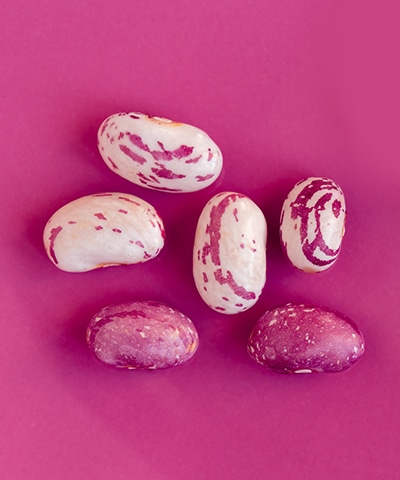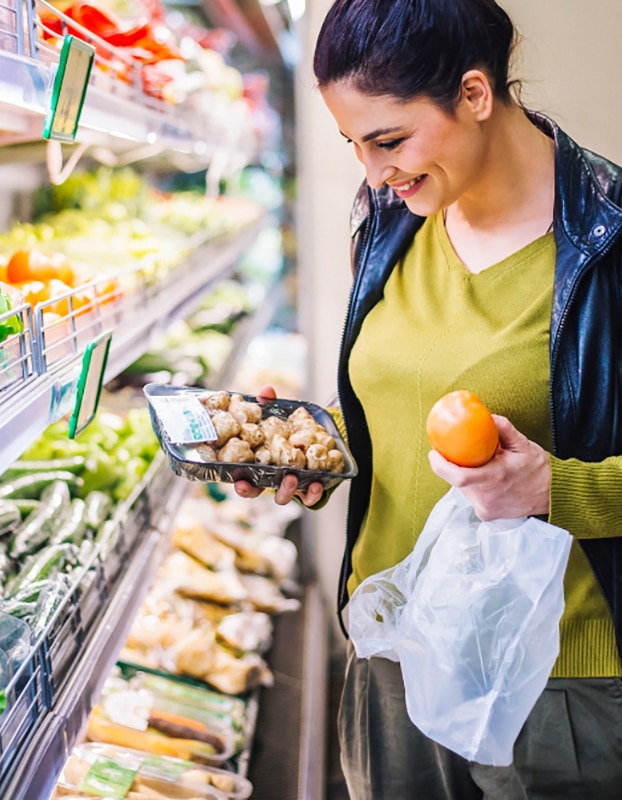It won’t cost much
to do the right thing
A cheap and healthy little bean!
Like all pulses, borlotti beans are among the most protein-rich plant-based foods. What’s more, they contain no fat. They’re a key to the food transition, as they can replace or accompany meat.
The good news is that borlotti beans are also good for the planet. They’re easy to grow and they support biodiversity. It’s all good!


Why borlotti beans
are good for you
Borlotti beans are rich in protein and fibre – two essential nutrients for a healthy diet! Dietary fibre is essential for bowel function, while protein plays many roles: maintain muscle mass, boost the immune system, and much more.
The nutritional value
of borlotti beans
Fusce sit amet hendrerit tortor. Fusce purus est, convallis nec sagittis a, venenatis eu libero. Fusce at leo tempus, vulputate.
The season
to eat it
Borlotti beans are harvested from July to September, but the good news is they are available all year round. In fact, they are preserved dried, and usually sterilised!
Growing
borlotti beans
Borlotti or borlotto beans are – as their name suggests – an ancient Italian variety. The pods are violet-red, and the beans are white with reddish-purple patches. They’re fairly easy to grow, in a humus-rich soil. Doesn’t this make you want to try them?
The seeds can be sown directly into the soil from May onwards. They prefer moist, humus-rich soil and sun. Borlotti beans are an annual plant, often grown as a bush or a climber.
Each pod contains 4 to 12 kidney-shaped beans, which are white with purple patches, and as beautiful as they are tasty. They offer exceptional taste for very low cost.
How to store
borlotti beans
To choose your borlotti beans, look out for freshness within the use-by date. The fresher the beans are, the easier they are to digest.
How best to store your borlotti beans? Keep them dry and away from light. They will keep for up to a year.
Tips
& tricks
How to prepare them
As with most dried beans, you first have to soak dried borlotti beans. Leave them in cold water for more than 12 hours or overnight, then rinse them well and cook in water for 1-1.30 hours. For added flavour, you can cook them in stock or add herbs or vegetables. Tinned beans simply need to be rinsed and warmed up.
The beans nutty taste goes well with sage, thyme, rosemary, marjoram, oregano, mint or lemon balm.
- Borlotti beans can be simmered slowly, added to stews, soups or pasta.
- They are also a delicious base for cakes or spreads.
- Cooked borlotti beans are also excellent in mixed salads, spiced up with a tangy dressing, like a balsamic vinaigrette. Combine with your choice of spices and fresh herbs.
Have any leftover borlotti beans? Don’t throw them away!
- Turn them into a soup with olive oil, garlic, onion and celery.
- Add them to a tuna, onion and tomato salad with a lemon yoghurt dressing.
- Add them to a vegetable stew or curry.
Can everyone
eat them?
Young children
Children can eat borlotti beans, as well as white beans, from the age of 15 months. Avoid giving them to younger children, as they can be harder to digest and they can swallow the beans the wrong way.
Everyone else
To ensure meeting your protein requirements, combine pulses, such as borlotti beans, with a cereal product, nuts and seeds, or dairy products.

A winning combo
for your protein intake
Eat borlotti beans with cereals, nuts or seeds. Generally speaking, it’s important to know that pulses don’t contain all the amino acids (protein-forming molecules) that our bodies need. Pulses are rich in lysine (one of the amino acids), but have very little methionine (another essential amino acid).
Cereal products (wheat, rice, etc.) and nuts and seeds, like dairy products, contain those essential amino acids that are lacking or present only in small quantities in pulses. By combining these foods with borlotti beans, you ensure a diet that contains an excellent balance of protein, even without meat.
It’s a winning combo of plant-based proteins! You don’t necessarily need to eat them together; they can be eaten throughout the day.
History
and origins
The main producers of dried beans are India, Brazil, Mexico, the United States, Indonesia and China. About 85% of dried beans are consumed in the countries where they are grown. In India and China, however, beans are mainly of the Vigna genus, in particular the mung bean. The borlotti bean originated in Italy, where it is still a common staple.



 Garlic
Garlic  Parsley
Parsley  Vegetable garden: growing beetroot
Vegetable garden: growing beetroot 









